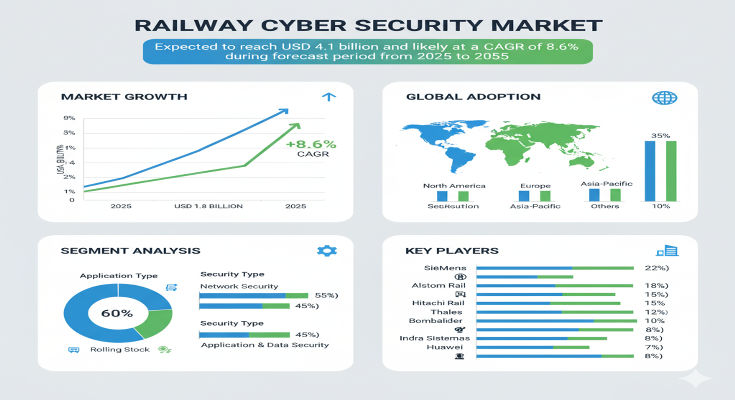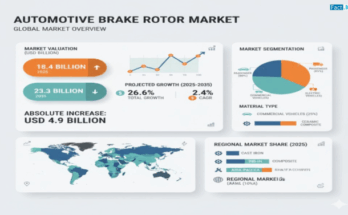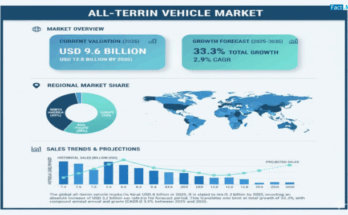The global railway cyber security market is projected to grow notably, expected to reach USD 4.1 billion by 2035, rising from a baseline in 2025 at a compound annual growth rate (CAGR) of 8.6% over the forecast period. This growth reflects the rising importance of cybersecurity across railway systems, as digitalisation, automation, IoT connectivity, passenger information systems, signalling systems, and operational control systems become more integrated and complex.
Market Drivers & Growth Catalysts
Multiple factors are driving demand for cyber security solutions in the the railway sector. As railway networks adopt more digital and connected technologies — such as IoT sensors, automated signalling, real-time data analytics, mobile ticketing, and integrated passenger information systems — the attack surface expands. Critical assets like train control, signalling, command & control systems, and station networks need robust protection to prevent data breaches, operational disruptions, and safety risks. Additionally, regulatory mandates in many countries require rail operators and infrastructure providers to adhere to stricter cybersecurity standards. Public-private investments in smart railroads, high-speed rail networks, urban metro systems, and digital modernization programs are amplifying demand for infrastructure security, network security, endpoint protection, data protection, application security, and system administration solutions.
Product & Security Type Segmentation
Railway cyber security solutions include offerings targeted at infrastructure security (stations, control centers, trackside assets), on-board / train systems, and network / operational technology (OT) interfaces. Major security types include network security, endpoint protection, application security, data protection, and broader system administration / compliance. Each domain requires tailored solutions because of the unique operational constraints: on-board systems must maintain safety and real-time responsiveness, while control centers must protect large volumes of passenger data, scheduling and signalling commands.
Regional Outlook & Opportunity Hotspots
Regional growth varies depending on infrastructure maturity and railway digitalization levels. Asia-Pacific is emerging as a key growth region due to rapid investment in high-speed rail, metro systems and digital transformation of railway networks. Countries such as China, India, Japan and Southeast Asian nations are heavily investing in railway modernization and integrating digital control / signalling, fueling demand for cyber security solutions. Meanwhile, mature regions such as North America and Western Europe are expanding adoption driven by upgrades to legacy rail infrastructure, commuter rail / metro systems, and stricter regulatory environments. Other regions (Latin America, Middle East & Africa) also present opportunities as rail networks expand and digital systems are introduced, though the uptake may be slower due to lower investment or limited regulatory enforcement.
Competitive Landscape & Strategic Trends
Key players in the railway cyber security space include system integrators, railway technology providers, cybersecurity firms, and vendors specializing in control systems / signalling. Companies are offering comprehensive solutions that integrate with on-board systems, network connectivity, passenger information, ticketing, and OT / IT convergence. Strategic initiatives include offering turnkey cybersecurity architectures for rail operators, combining network monitoring, anomaly detection, endpoint protection on trains, data encryption, and compliance management. Many solution providers are expanding partnerships with rail operators or infrastructure owners to integrate security into both new systems (e.g. modernization projects) and retrofit upgrades for legacy systems.
Challenges & Market Restraints
Despite promising growth, there are several challenges. Legacy railway systems often run on older control infrastructure or proprietary signalling networks that are harder to secure, requiring custom integration or retrofitting. The long service life of railway assets means slower hardware replacement cycles. There is also complexity in securing on-board systems that must maintain real-time control and safety. Regulatory and certification requirements vary by region, meaning providers must adapt to different standards. In emerging markets, limited technical expertise or lower IT maturity can slow the adoption of advanced cybersecurity solutions.
Forecast & Strategic Recommendations
With the market projected to grow at an 8.6% CAGR through 2035 to reach around USD 4.1 billion, stakeholders should focus on developing integrated cyber security solutions tailored to railway needs. Rail operators, infrastructure owners and system integrators ought to invest in modular security solutions that cover on-board, network and infrastructure layers. Expansion in high-growth regions like Asia-Pacific is vital; local partnerships and compliance adaptation will help penetrate those markets. Solution providers should also offer training and managed security services to assist operators with operations & maintenance of security over legacy and new systems.
Browse Full Report: https://www.factmr.com/report/4007/railway-cyber-security-market
Editorial Perspective
Railways are no longer just physical assets — they are cyber-physical networks where digital systems control trains, passengers, scheduling and infrastructure. Each digital interface introduces vulnerability. The next decade will be defined by how rail operators adapt to cyber threats while scaling digitalization. The projected market growth signifies that cyber security is no longer optional — it is integral to safe, reliable and efficient railway operations. Companies that can embed robust cybersecurity into railway infrastructure, train systems and control networks will become foundational partners in the digital railway era



